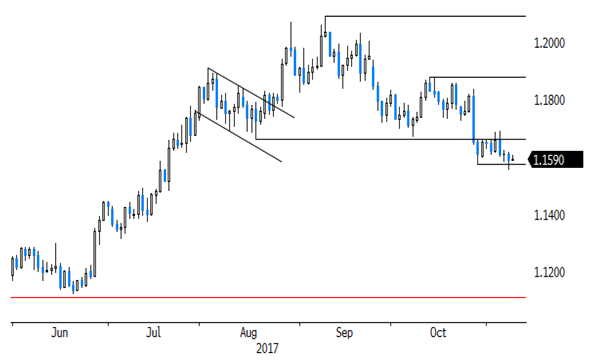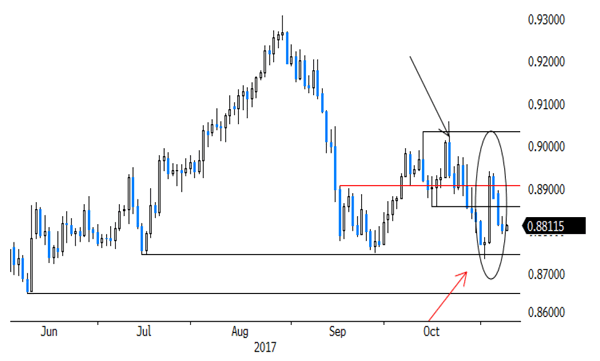Sunrise Market Commentary
- Rates: Will Japanese stock volatility spread to Europe?
Stock markets could influence core bond markets today if the overnight volatility on Japanese equity markets spreads to Europe and the US. Don’t forgot that the German Dax already showed a bearish engulfing pattern on Tuesday. Safe haven flows are positive for bonds in this scenario and could trigger a new test of 163.43 resistance in the Bund. - Currencies: Will volatility unlock stalemate in major FX cross rates?
Of late USD/JPY and EUR/USD were confined to tight ranges. There are again few important eco data today. A rise in global market volatility might weigh on USD/JPY and EUR/JPY. We see little upside for EUR/USD in such a scenario. Sterling traders keeps a close eye on the next round of the Brexit negotiations
The Sunrise Headlines
- US stock markets closed slightly higher yesterday with Nasdaq outperforming (+0.3%). Asian stock markets are volatile overnight with Japanese stocks revering a 2% gain in a sudden slide.
- The RBNZ kept its policy rate unchanged at 1.75%, but revised up its inflation forecasts and signalled it may have to start tightening earlier than previously expected.
- EU is giving UK an informal deadline of two to three weeks to set out how much it is prepared to pay in the Brexit divorce settlement, the Financial Times reports, citing an unidentified senior EU negotiator.
- Chinese CPI picked up unexpectedly last month (1.9% Y/Y from 1.6% Y/Y)) as pork price falls eased and fuel costs rose at a quicker clip, while a recent run of acceleration for PPI appeared to lose some of its steam (stable at 6.9% Y/Y).
- President Trump said China is taking advantage of American workers and companies with unfair trade practices, but he blamed his predecessors rather than China for allowing the massive US trade deficit to grow.
- Record high prices combined with more risky corporate bond supply is creating ‘increasing uncertainty’ and raising the chances of a sharp turnaround in the European high-yield credit market, Fitch has warned yesterday.
- Today’s eco calendar contains US weekly jobless claims. Ireland and the US tap the bond market. ECB Nouy, Coeuré, Mersch, Constancio, Villeroy, Weidmann and Lautenschlaeger are all scheduled to speak
Currencies: Will Volatility Unlock Stalemate In Major FX Cross Rates?
Will global (FX) trading become more volatile?
Trading in the major USD cross rates was technical in nature yesterday in absence of eco data. Risk sentiment eased temporary. This ‘risk correction’ kept core yields near recent lows and caused an intraday setback in the likes of USD/JPY and EUR/JPY. EUR/USD was little affected and kept a very narrow range near 1.16. However, US equities soon resumed the established record race, reversing the intraday gains of the yen. USD/JPY finished the session at 113.87 (from 114.01).
Asian equities show wild swings this morning. The record race initially simply continued. However, several indices including the Nikkei fell off a cliff in afternoon trading. We didn’t see a specific reason. The decline occurred as US president Trump spoke tough on the US trade deficit in a meeting with Chinese President Xi Jinping. It’s not sure whether his comments triggered the correction (intraday losses in China are more modest than e.g. in Japan). At the time of writing, the sell-off stalls. The impact on EUR/USD (1.16 area) is again negligible. USD/JPY returned to the mid 113 area. Late yesterday, the RBNZ left its policy rate unchanged at 1.75%. The RBNZ was a bit more hawkish than expected. NZD/USD rebounded slightly after the policy announcement (currently 0.6955). RBNZ’s McDermott considers the level of kiwi dollar about right.
EMU and US eco data (German trade balance, US jobless claims and Wholesale data) are unlikely to have a lasting impact on core yields or on the major FX cross rates. There are plenty of ECB speakers and the EC will publish its autumn forecasts. The developments in the set-up of the US tax bill remain a wild card for global risk sentiment and the dollar.
The US currency showed a mixed/diffuse picture over the previous days. USD/JPY failed to break above the MT range top (114.49/114.73). EUR/USD held a tight range close to the post-ECB low. A high absolute interest rate differential and the prospect that any ECB tightening is still very far away forced some EUR/USD longs to scale back exposure, keeping EUR/USD under (modest) downside pressure. We assume that any sustained EUR/USD rebound will be difficult short-term, unless there is high profile negative news from the US (e.g. no agreement on a tax bill). The jury is still out whether this morning’s volatility on Asian markets will filter through into European and/or US markets. A less positive risk sentiment will evidently be negative for USD/JPY. However, we doubt that it will be of much help for EUR/USD. (Risk of EUR/JPY selling weighing on EUR/USD, too ?).We maintain a EUR/USD sell-on-upticks bias.
From a technical point of view, EUR/USD dropped below 1.1670/62 support, the subsequent follow-through price action occurred very slowl. Still the pair dropped to a new post-ECB low on Tuesday. A sustained break would confirm that the recent EUR/USD uptrend is broken. EUR/USD 1.1423 (38% retracement of 2017 rise) is the next downside target on the charts. USD/JPY’s momentum was positive in past months. The pair regained 110.67/95 resistance and tested the 114.49 MT range top, but the attempt failed. A sustained break would improve the technicals. We remain cautious to preposition for further USD/JPY gains. This week’s price action remains unconvincing.

EUR/USD: no follow-through losses, for now
EUR/GBP
Brexit again in focus for sterling trading
On Friday and earlier this week, sterling reversed most of the decline after last week’s soft BoE policy statement. However, UK politics again came to haunt sterling yesterday. There were plenty of press reports that International Developments Secretary Patel could be fired on unauthorized contacts with Israeli officials. She finally resigned yesterday evening, the second removal of a UK Cabinet member within a week. At the same time, EU policy makers continued to stress the need for more clarity on the UK separation bill. Cable dropped temporary below 1.31, but closed the session off the intraday low (1.3116). EUR/GBP rebounded to the 0.8860 area, but a modest sterling comeback made the cross rate close at 0.8840.
Overnight, the RICS house price balance was softer than expected at 1% (from 6%, 4% was expected).There was no lasting negative impact on sterling. The focus for sterling trading will be on the next round of Brexit negotiations. Sterling is regaining a few ticks across the board this morning. Markets apparently still hope for some progress or at least that the negotiating parties will avoid negative comments. We don’t preposition for a positive breakthrough yet. We expect EUR/GBP to stabilize/look for a bottom. A further decline of EUR/USD might hamper a EUR/GBP rebound short-term.
MT technical: Sterling rebounded in September as the BoE prepared markets for a rate hike. This rebound ran into resistance as markets anticipated that any rate hikes would be very gradual and limited. This view was confirmed at last week’s BoE policy meeting. EUR/GBP currently trades in a 0.8733/0.9033 consolidation range. A downside test of this range was rejected last week. We maintain the view that the 0.8733 -0.8652 support area will be tough to break in a sustainable way. A EUR/GBP buy-on-dips approach is favoured. EUR/GBP 0.9023/33 is the first important resistance.

EUR/GBP: off recent low, but no sustained rebound, yet














